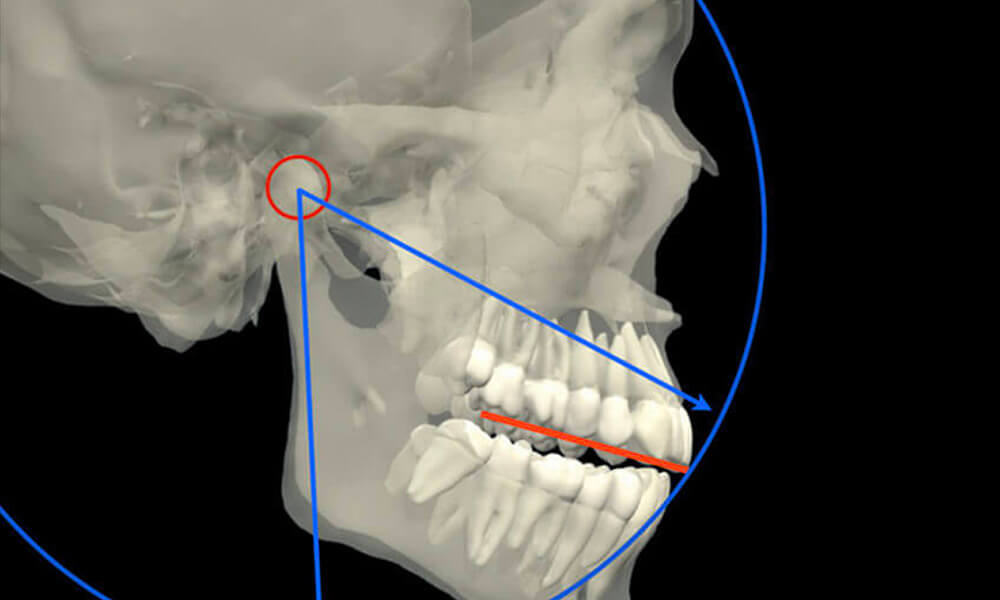
Arc of Rotation & Heavy Posterior Contacts
Have you ever had a night guard or other full coverage dental device come back with contact only in the posterior or heavy in the posterior? It is a fairly common phenomenon. And it is a big challenge when doing two-jaw hybrid surgery and placing the temporary restorations on the day of the surgery.
I became aware of this big challenge when my oral surgeon came across the parking lot one day to discuss the upper and lower hybrid case of one of our mutual patients. This was the first hybrid case we would be doing together. He had been using a company with a software platform that does his implant planning and digital setup, and then produces his surgical guides and provisional restorations. It can even produce the final restorations. He related to me that when he tries in the initial prostheses, he always finds they are heavy in the posterior.
So, I asked him, “When they ask you for records, what do you send them?” He said they request either an upper and lower scan, or upper and lower BPS impressions, or upper and lower models. They also want a bite record and a shade. As he went down the list, something was missing that has to do with heavy posterior contacts.
Whether it is premade upper and lower provisional restorations when you are doing extractions, implants, and hybrids — or it is a nightguard you get back from the lab or Invisalign trays that you receive from Invisalign, there are occasions when we find prostheses are heavy on the posterior contacts. Sometimes there are no anterior contacts. That’s because, across the board, prostheses need to be fabricated knowing the arc of rotation, which is the distance between the hinge axis at the center of the condyle and the upper anterior teeth.
A full arch impression taken without a facebow transfer, either hand articulated or with a bite registration only over the prepared teeth, only provides the same information about maximum intercuspal position as a triple tray. If we mount the full arch impressions on a simple hinge articulator, the articulation used does not represent the arc of rotation. If we are digitizing the impressions for a digital system, we also are missing this essential piece of diagnostic information. We must have impressions mounted on an articulator with a facebow or dental-facial analyzer (DFA).
I explained this to my oral surgeon who became concerned he would not be able to deliver this information to the implant planning company he was using. But this story has a happy ending. He called the company to learn if they could use articulated models mounted with a DFA or facebow. It turns out they much prefer this! And they told him the specific articulator systems for which they have corollaries in the digital world. If he sends the models mounted on any of these, they can digitize them and know the arc of rotation.
Those who have been in my presentations have heard this many times before. The more esthetic and functional information we send to the laboratory the higher will be our ability to efficiently manage the functional and esthetic issues of the case precisely. A lesson we can learn from this story is the value of conversing with the specialists on our interdisciplinary teams and in our interdisciplinary study clubs about the importance of capturing and communicating the arc of rotation. If a laboratory is not requesting this information, have a conversation with the laboratory.
The primary purpose of Panadent’s DFA or any of the earbow/facebow systems is to capture this critical piece of information we call the arc of rotation. There is other information these systems capture but the arc of rotation is critical in establishing proper occlusion. I’ve written about Panadent’s DFA in a previous blog. For an in-person, hands-on lesson in the dento-facial analyzer, we invite you to attend our Essentials 1 Pankey course. You can also watch this video for a quick refresher.
Related Course
E4: Posterior Reconstruction and Completing the Comprehensive Treatment Sequence
DATE: February 27 2025 @ 8:00 am - March 3 2025 @ 2:30 pmLocation: The Pankey Institute
CE HOURS: 44
Dentist Tuition: $ 7400
Single Occupancy with Ensuite Private Bath (per night): $ 345
THIS COURSE IS SOLD OUT The purpose of this course is to help you develop mastery with complex cases involving advanced restorative procedures, precise sequencing and interdisciplinary coordination. Building on…
Learn More>






